The AMD 2nd Gen Ryzen Deep Dive: The 2700X, 2700, 2600X, and 2600 Tested
by Ian Cutress on April 19, 2018 9:00 AM ESTCPU Encoding Tests
One of the interesting elements on modern processors is encoding performance. This includes encryption/decryption, as well as video transcoding from one video format to another. In the encrypt/decrypt scenario, this remains pertinent to on-the-fly encryption of sensitive data - a process by which more modern devices are leaning to for software security. Video transcoding as a tool to adjust the quality, file size and resolution of a video file has boomed in recent years, such as providing the optimum video for devices before consumption, or for game streamers who are wanting to upload the output from their video camera in real-time. As we move into live 3D video, this task will only get more strenuous, and it turns out that the performance of certain algorithms is a function of the input/output of the content.
All of our benchmark results can also be found in our benchmark engine, Bench.
7-Zip 9.2: link
One of the freeware compression tools that offers good scaling performance between processors is 7-Zip. It runs under an open-source licence, is fast, and easy to use tool for power users. We run the benchmark mode via the command line for four loops and take the output score.
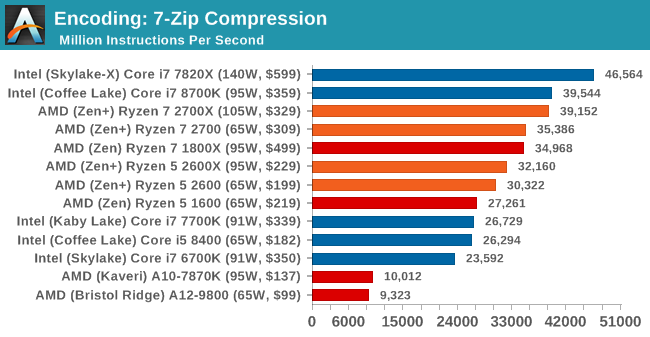
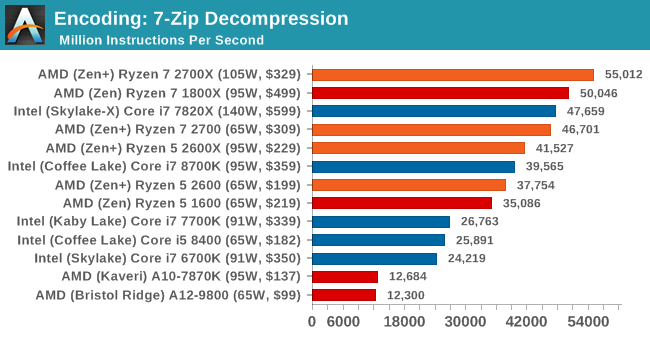

WinRAR 5.40: link
For the 2017 test suite, we move to the latest version of WinRAR in our compression test. WinRAR in some quarters is more user friendly that 7-Zip, hence its inclusion. Rather than use a benchmark mode as we did with 7-Zip, here we take a set of files representative of a generic stack (33 video files in 1.37 GB, 2834 smaller website files in 370 folders in 150 MB) of compressible and incompressible formats. The results shown are the time taken to encode the file. Due to DRAM caching, we run the test 10 times and take the average of the last five runs when the benchmark is in a steady state.

WinRAR requires a good memory base, so we see the quad-channel processors heading up the pack. The high IPC of the Core i7-8700K also does well.
AES Encoding
Algorithms using AES coding have spread far and wide as a ubiquitous tool for encryption. Again, this is another CPU limited test, and modern CPUs have special AES pathways to accelerate their performance. We often see scaling in both frequency and cores with this benchmark. We use the latest version of TrueCrypt and run its benchmark mode over 1GB of in-DRAM data. Results shown are the GB/s average of encryption and decryption.
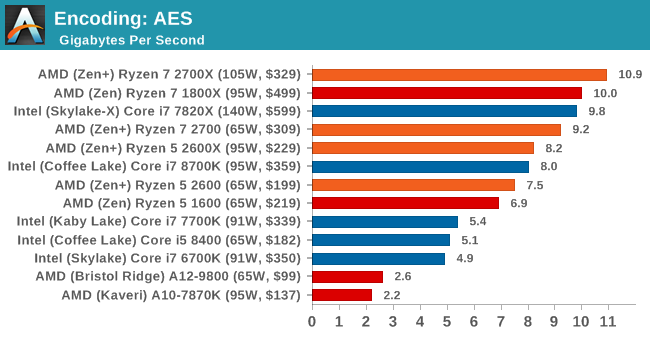
HandBrake v1.0.2 H264 and HEVC: link
As mentioned above, video transcoding (both encode and decode) is a hot topic in performance metrics as more and more content is being created. First consideration is the standard in which the video is encoded, which can be lossless or lossy, trade performance for file-size, trade quality for file-size, or all of the above can increase encoding rates to help accelerate decoding rates. Alongside Google's favorite codec, VP9, there are two others that are taking hold: H264, the older codec, is practically everywhere and is designed to be optimized for 1080p video, and HEVC (or H265) that is aimed to provide the same quality as H264 but at a lower file-size (or better quality for the same size). HEVC is important as 4K is streamed over the air, meaning less bits need to be transferred for the same quality content.
Handbrake is a favored tool for transcoding, and so our test regime takes care of three areas.
Low Quality/Resolution H264: Here we transcode a 640x266 H264 rip of a 2 hour film, and change the encoding from Main profile to High profile, using the very-fast preset.
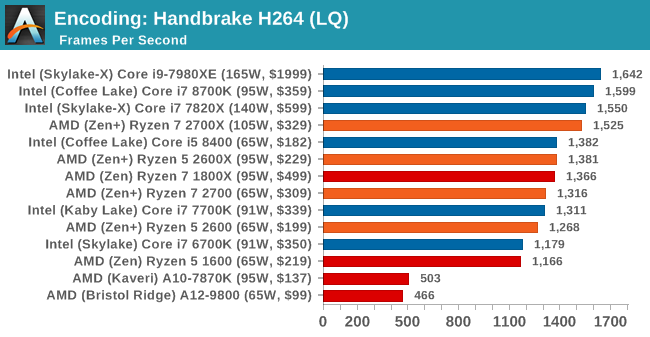
High Quality/Resolution H264: A similar test, but this time we take a ten-minute double 4K (3840x4320) file running at 60 Hz and transcode from Main to High, using the very-fast preset.
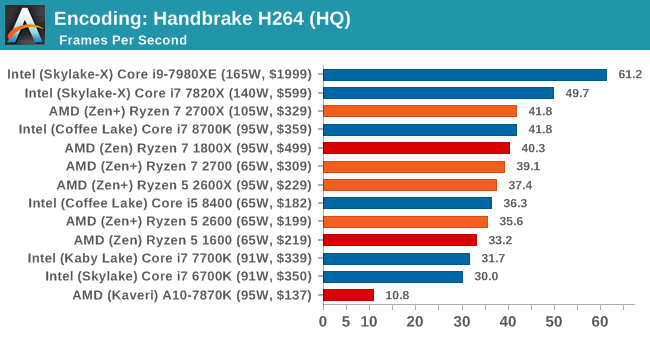
HEVC Test: Using the same video in HQ, we change the resolution and codec of the original video from 4K60 in H264 into 4K60 HEVC.
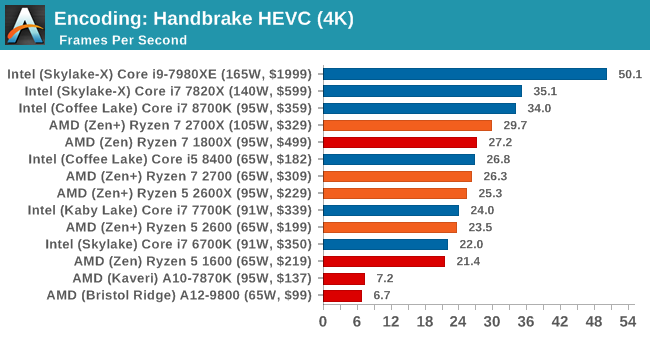
For HandBrake video encoding of large frames, there is a bump with the new Ryzen-2000 series processors over the previous generation, however there is still a gap up to the Core i7-8700K. The Core i5-8400 puts in a good showing here, above all but the best Ryzen parts.










545 Comments
View All Comments
fallaha56 - Thursday, April 19, 2018 - link
I’m not -I’m jst showing how stupid your OP wasIf someone is selling an entry level chip for the same price as someone else’s that’s the comparison
Include the platform costs if you like but that’s what matters -bang for buck
Only for .1% of people does performance at any costs matter
Ninjawithagun - Thursday, April 19, 2018 - link
Actually no. Once again proving you do not know how to count to 8.LurkingSince97 - Thursday, April 19, 2018 - link
Um... NO.Sure, in some cases it is possible to compare two processors of 'equal quality' and then look at cost second.
But that is an impossible task in a review. And for some processors it is impossible for anyone.
This is impossible because there is no such thing as an 'equal quality chip'. Subjectively, I might be able to find two chips that I think are roughly equal, then compare price. But this is subjective -- depending on what my needs are.
Price is objective. We can compare two system builds at nearly equal cost directly, then see what is better. Comparing 'roughly equal' chips first starts out in the wrong place for most consumers. Only those that are not very price sensitive do that -- get the 'best' for what they want, and if there are two equal things use price as a tie breaker. Most people are looking for the best they can get for a price, rather than the lower price for what they want.
Now, to make it worse, by your reasoning the 2700X can not be compared to anything, because the core counts differ. Bull$#17. I could just as easily say that the 8700K can not be compared to the 2600X because it can overclock to 5Ghz, so they are not technically the same.
There is absolutely reason to compare 8C/16T products to 6C/12T to 4C/8T products -- BECAUSE PEOPLE HAVE TO PICK ONE TO BUY.
LurkingSince97 - Thursday, April 19, 2018 - link
Incorrect. Q.E.D.bji - Thursday, April 19, 2018 - link
You are completely wrong, and Krysto is correct. Performance per dollar is the metric of greatest relevance for the vast majority of users and thus is the most useful metric to use in reviews.mapesdhs - Saturday, April 21, 2018 - link
Maybe Ninjawithagun is just crazy rich and doesn't care about price. :)Targon - Monday, April 23, 2018 - link
Performance per dollar for the workload you care about is what you are talking about, since game performance doesn't matter much in business, but being able to do whatever the day to day work as quickly as possible is. That may mean lower core counts with high clock speeds will be more important, or higher core counts will beat out most other things(16+ cores at 1.5GHz might beat out 4 cores at 5GHz). It all depends.Ryan Smith - Thursday, April 19, 2018 - link
"Why does every review keep making the same mistake?? It has nothing to do with price. Comparing like CPU architectures is the only logical course of action."To abuse an already overused meme here, why not both? This is why we have the data for all of these parts.
Our focus is on price comparisons, because at the end of the day most readers will make their buying decisions around a given budget. But there is also plenty here looking into IPC and other architectural elements.
Cooe - Thursday, April 19, 2018 - link
Lol don't feed him Ryan! As one of our so gracious and glorious overloads it pains me to see you get into the mud with that dingus. Leave that to us nobodies :).Ninjawithagun - Thursday, April 19, 2018 - link
Ignorance is your bliss.